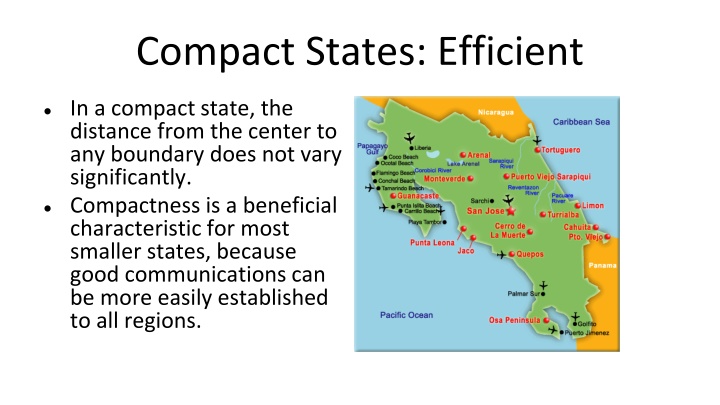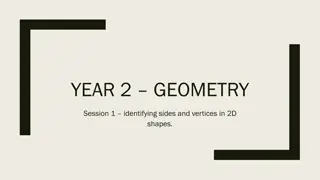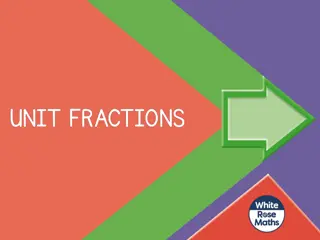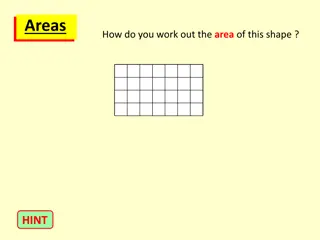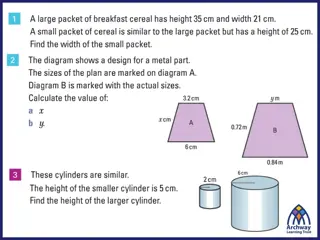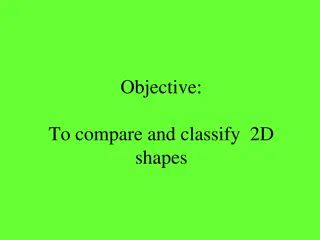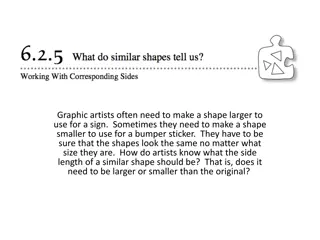Characteristics of Different State Shapes Explained
Compact states have efficient communication due to their balanced shape, while prorupted states extend for access or disruption. Elongated states face potential isolation issues, and fragmented states are problematic with territorial pieces separated. Perforated states, like South Africa, completely surround another state. Landlocked states, such as Lesotho, lack direct ocean access, impacting international trade.
Download Presentation

Please find below an Image/Link to download the presentation.
The content on the website is provided AS IS for your information and personal use only. It may not be sold, licensed, or shared on other websites without obtaining consent from the author.If you encounter any issues during the download, it is possible that the publisher has removed the file from their server.
You are allowed to download the files provided on this website for personal or commercial use, subject to the condition that they are used lawfully. All files are the property of their respective owners.
The content on the website is provided AS IS for your information and personal use only. It may not be sold, licensed, or shared on other websites without obtaining consent from the author.
E N D
Presentation Transcript
Compact States: Efficient In a compact state, the distance from the center to any boundary does not vary significantly. Compactness is a beneficial characteristic for most smaller states, because good communications can be more easily established to all regions.
Prorupted States: Access or Disruption An otherwise compact state with a large projecting extension is a prorupted state. Proruptions are created for two principal reasons. First, a proruption can provide a state with access to a resource, such as water. Proruptions can also separate two states that otherwise would share a boundary.
Elongated States: Potential Isolation There are a handful of elongated states, or states with a long and narrow shape. The best example is Chile. A less extreme example of an elongated state is Italy. Elongated states may suffer from poor internal communications.
Fragmented States: Problematic A fragmented state includes several discontinuous pieces of territory. There are two kinds of fragmented states: those with areas separated by water, and those separated by an intervening state. A difficult type of fragmentation occurs if the two pieces of territory are separated by another state. Picture the difficulty of communicating between Alaska and the lower 48 states if Canada were not a friendly neighbor. For most of the twentieth century, Panama was an example of a fragmented state divided in two parts by the Canal, built in 1914 by the United States.
Perforated States: South Africa A state that completely surrounds another one is a perforated state. The one good example of a perforated state is South Africa, which completely surrounds the state of Lesotho.
Landlocked States Lesotho is unique in being completely surrounded by only one state, but it shares an important feature with several other states in southern Africa, as well as in other regions: It is landlocked. The prevalence of landlocked states in Africa is a remnant of the colonial era, when Britain and France controlled extensive regions. Direct access to an ocean is critical to states because it facilitates international trade. To send and receive goods by sea, a landlocked state must arrange to use another country s seaport.
Mountain Boundaries Mountains can be effective boundaries if they are difficult to cross (and) because they are rather permanent and usually are sparsely inhabited. Mountains do not always provide for the amicable separation of neighbors. Argentina and Chile agreed to be divided by the crest of the Andes Mountains but could not decide on the precise location of the crest.
Desert Boundaries Like mountains, deserts are hard to cross and sparsely inhabited. Desert boundaries are common in Africa and Asia.
Water Boundaries Rivers, lakes, and oceans are the physical features most commonly used as boundaries. Water boundaries are especially common in East Africa. Boundaries are typically in the middle of the water, although the boundary between Malawi and Tanzania follows the north shore of Lake Malawi (Lake Nyasa). Again, the boundaries result from nineteenth-century colonial practices: Malawi was a British colony, whereas Tanzania was German. Water boundaries can offer good protection against attack from another state, because an invading state must secure a landing spot. The state being invaded can concentrate its defense at the landing point.
Geometric Boundaries Part of the northern U.S. boundary with Canada is a 2,100-kilometer (1,300- mile) straight line (more precisely, an arc) along 49 north latitude, . . . established in 1846 by a treaty between the United States and Great Britain, which still controlled Canada. The United States and Canada share an additional 1,100-kilometer (700-mile) geometric boundary between Alaska and the Yukon Territory along the north-south arc of 14 west longitude.
Ethnic Groups in Southwest Asia Fig. 8-14: Ethnic boundaries do not match country boundaries, especially in Iraq, Iran, Afghanistan, and Pakistan.
Unitary and Federal States In the face of increasing demands by ethnicities for more self-determination, states have restructured their governments to transfer some authority from the national government to local government units. The governments of states are organized according to one of two approaches: the unitary system or the federal system. The unitary state places most power in the hands of central government officials, whereas the federal state allocates strong power to units of local government within the country.
Unitary and Federal States Continued Unitary states are especially common in Europe. In reality, multinational states often have adopted unitary systems, so that the values of one nationality can be imposed on others. In a federal state, such as the United States, local governments possess more authority to adopt their own laws. Multinational states may adopt a federal system of government to empower different nationalities, especially if they live in separate regions of the country. The federal system is also more suitable for very large states because the national capital may be too remote to provide effective control over isolated regions.
France: Curbing a Unitary Government A good example of a nation-state, France has a long tradition of unitary government in which a very strong national government dominates local government decisions. Their basic local government unit is the d partement. A second tier of local government in France is the commune. The French government has granted additional legal powers to the departments and communes in recent years. In addition, 22 regional councils that previously held minimal authority have been converted into full-fledged local government units.
Poland: A New Federal Government Poland switched from a unitary to a federal system after control of the national government was wrested from the Communists. Under the Communists unitary system, local governments held no legal authority. Poland s 1989 constitution called for a peaceful revolution: creation of 2,400 new municipalities, to be headed by directly elected officials. To these municipalities, the national government turned over ownership of housing, water supplies, transportation systems, and other publicly owned structures. Businesses owned by the national government were either turned over to the municipalities or converted into private enterprises.
Autocracy - The power and authority to rule are in the hands of a single individual. Sovereignty is in the hands of one - the king, queen, emperor, tsar, dictator, etc. Absolute Monarchy A king, queen, emperor, or tsar exercises the supreme power of government. Power is usually inherited. The ruler has complete and unlimited power to rule. Examples: China during the Dynastic period (until 1911) Russia until the Communist Revolution, 1917 France until the French Revolution, 1789 Saudi Arabia Kuwait Qatar Totalitarian Dictatorship A leader exercises authoritarian power over every aspect of human affairs. Power is usually not inherited, but it is acquired by force and often reinforced by propaganda. Suppression of any opposition is often a characteristic of this type of government. Examples: Germany under Hitler Italy under Mussolini Soviet Union under Stalin Libya under Qaddafi
